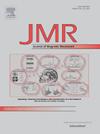Strong field gradients enable NMR-based diffusion measurements for K+, Mg2+, Cl−, and SO42− ions in biomolecular solutions
IF 1.9
3区 化学
Q3 BIOCHEMICAL RESEARCH METHODS
引用次数: 0
Abstract
NMR-based diffusion measurements of potassium (K+), magnesium (Mg2+), chloride (Cl−), and sulfate (SO42−) ions have been challenging even though these ions are biologically important. For these ions, the gyromagnetic ratios of the NMR-active nuclei, 39K, 25Mg, 35Cl, and 33S, are less than 1/10 of the 1H gyromagnetic ratio, causing a low sensitivity in NMR detection and a low efficiency in NMR dephasing needed for diffusion measurements. These nuclei also undergo rapid longitudinal and transverse NMR relaxation via the quadrupolar mechanism, severely limiting the effectiveness of NMR-based diffusion measurements. Interactions with biomolecules promote the NMR relaxation of these ions, hindering measurements of the ion diffusion. We demonstrate that, despite these challenges, diffusion of K+, Mg2+, Cl−, and SO42− ions in biomolecular solutions can be measured accurately and precisely through use of appropriately designed high-field NMR probe hardware that can generate strong field gradients >1000 G/cm. The NMR-based diffusion coefficients measured at 17.6 T for these ions in the absence of biomolecules agreed well with conductivity-based values in the literature. This consistency supports that ion diffusion along the magnetic field is unaffected by the Lorentz force acting on the ions, as previously predicted. Our data on ion diffusion in solutions of proteins and DNA illuminate the effect of electrostatic interactions on the apparent diffusion coefficients of ions. Thus, high-field NMR probe hardware that can generate strong field gradients opens a new avenue to characterize the dynamic behavior of various ions around biomolecules and their effect on biomolecular electrostatics.

强场梯度使核磁共振为基础的扩散测量K+, Mg2+, Cl−和SO42−离子在生物分子溶液
基于核磁共振的钾离子(K+)、镁离子(Mg2+)、氯离子(Cl−)和硫酸盐离子(SO42−)的扩散测量一直具有挑战性,尽管这些离子在生物学上很重要。对于这些离子,核磁共振活性核(39K、25Mg、35Cl和33S)的回旋磁比小于1H回旋磁比的1/10,导致核磁共振检测灵敏度低,扩散测量所需的核磁共振减相效率低。这些核也通过四极性机制经历快速的纵向和横向核磁共振弛豫,严重限制了核磁共振扩散测量的有效性。与生物分子的相互作用促进了这些离子的核磁共振弛豫,阻碍了离子扩散的测量。我们证明,尽管存在这些挑战,但通过使用适当设计的高场核磁共振探针硬件,可以准确地测量生物分子溶液中K+, Mg2+, Cl−和SO42−离子的扩散,该探针硬件可以产生1000 G/cm的强场梯度。在没有生物分子的情况下,这些离子在17.6 T下的核磁共振扩散系数与文献中基于电导率的值很好地一致。这种一致性支持离子沿磁场扩散不受作用在离子上的洛伦兹力的影响,正如先前预测的那样。我们在蛋白质和DNA溶液中离子扩散的数据阐明了静电相互作用对离子表观扩散系数的影响。因此,可以产生强场梯度的高场核磁共振探针硬件为表征生物分子周围各种离子的动态行为及其对生物分子静电的影响开辟了新的途径。
本文章由计算机程序翻译,如有差异,请以英文原文为准。
求助全文
约1分钟内获得全文
求助全文
来源期刊
CiteScore
3.80
自引率
13.60%
发文量
150
审稿时长
69 days
期刊介绍:
The Journal of Magnetic Resonance presents original technical and scientific papers in all aspects of magnetic resonance, including nuclear magnetic resonance spectroscopy (NMR) of solids and liquids, electron spin/paramagnetic resonance (EPR), in vivo magnetic resonance imaging (MRI) and spectroscopy (MRS), nuclear quadrupole resonance (NQR) and magnetic resonance phenomena at nearly zero fields or in combination with optics. The Journal''s main aims include deepening the physical principles underlying all these spectroscopies, publishing significant theoretical and experimental results leading to spectral and spatial progress in these areas, and opening new MR-based applications in chemistry, biology and medicine. The Journal also seeks descriptions of novel apparatuses, new experimental protocols, and new procedures of data analysis and interpretation - including computational and quantum-mechanical methods - capable of advancing MR spectroscopy and imaging.

 求助内容:
求助内容: 应助结果提醒方式:
应助结果提醒方式:


